


MAXIMILIEN ROBESPIERRE 1758 -
xxxxxThe French lawyer Maximilien Robespierre, a prominent figure in the French Revolution, will always be associated with the Reign of Terror. An uncompromising democrat who was much influenced by the writings of Jean Jacques Rousseau, he became a member of the States General in 1789 and, a year later, leader of the radical Jacobin Club. He played a part in the overthrow of Louis XVI in August 1792, and did not disguise his support for the September Massacres the following month. He was elected to the National Convention that month, where he called for the execution of the monarch and democratic reforms. In April 1793 he was instrumental in overthrowing the moderate Girondist party, and then virtually seized control of the country on joining the Committee of Public Safety in the July. Here this quiet, learned man revealed a determined, ruthless streak. Having helped to put the country on a war footing, he introduced a Reign of Terror in the September, designed to eliminate any persons suspected of being opposed to the revolution. Thousands were sent to the guillotine, including his opponents in the radical party, led by Hébert, and moderates such as his friend and ally Danton. After ten months of slaughter, a reaction set in against the bloodbath. He was arrested in July 1794, and was himself sent to the guillotine.
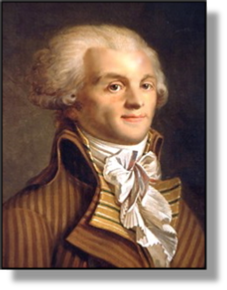 xxxxxAlong with Georges Danton, Robespierre’s name is forever linked with the Reign of Terror which gripped the French Revolution from September 1793 to July 1794. This apart, the two men, though united in their unwavering support of the common people, were very different in appearance and temperament. Danton, apart from being a tall, well-
xxxxxAlong with Georges Danton, Robespierre’s name is forever linked with the Reign of Terror which gripped the French Revolution from September 1793 to July 1794. This apart, the two men, though united in their unwavering support of the common people, were very different in appearance and temperament. Danton, apart from being a tall, well-
xxxxxHe was born at Arras, full name Maximilien François Marie Isidore Robespierre. He attended the College of Louis-
xxxxxIn April 1790 his rise to power received a boost when he was elected president of the Jacobin Club, an extreme republican group, formed the previous year. From this vantage point, he came out as an enemy of the monarchy and an ardent opponent of the moderate Girondists, then seeking compromise and holding sway in the newly formed Legislative Assembly. It was to rid the government of both king and Girondists that in August 1792, as the fear of invasion swept the country, he helped to promote the republican revolution which brought the downfall of the monarchy. Then the following month he gave undisguised support to the slaughter of imprisoned nobles and clergy -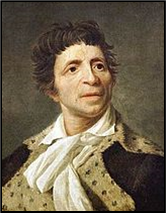 was about to erupt.
was about to erupt.
xxxxxIn September 1792 Robespierre was elected to the National Convention as a deputy for Paris, and he now came out openly in favour of the execution of the king, who was strongly suspected of being in league with both the Austrians and Prussians in their bid to destroy the revolution. Following the king’s execution in early 1793, his opportunity to seize power came in June 1793 when, together with the fanatical Jean Paul Marat (illustrated), he managed to overthrow the Girondists in the National Convention and, the following month, gained election to the Committee of Public Safety. This body, designed to defend the nation and strengthen its resolve, had been formed in April, but with Danton at its head, had attempted to compromise on both fronts. Robespierre, virtually assuming dictatorial powers, changed all that. Quite apart from putting the country on a war footing, and sending armies to put down rebellion in the provinces, he embarked upon a brutal campaign of abject fear as the only means, as he saw it, of eliminating anti-
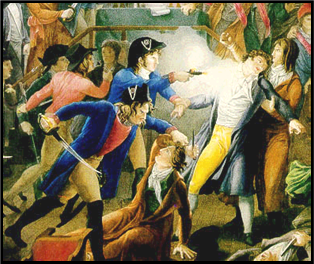 xxxxxBy the New Year his overriding passion for social reform began to know no bounds. InxApril, he pounced upon the extreme radical group led by Jacques-
xxxxxBy the New Year his overriding passion for social reform began to know no bounds. InxApril, he pounced upon the extreme radical group led by Jacques-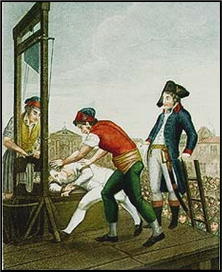 of the National Convention in June 1794, but on the 26th a republican victory over the Austrians at the Battle of Fleurus made extreme security measures less urgent. A conspiracy was formed against him, and the following month orders went out for his arrest. Trapped in the city hall, he attempted to commit suicide by shooting himself in the head, but he only succeeded in shattering his jaw. (Though some accounts have it that he was shot at the time of his arrest -
of the National Convention in June 1794, but on the 26th a republican victory over the Austrians at the Battle of Fleurus made extreme security measures less urgent. A conspiracy was formed against him, and the following month orders went out for his arrest. Trapped in the city hall, he attempted to commit suicide by shooting himself in the head, but he only succeeded in shattering his jaw. (Though some accounts have it that he was shot at the time of his arrest -
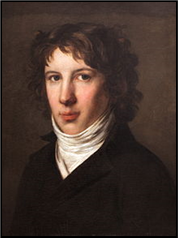 xxxxxIncidentally, guillotined along with Robespierre was his loyal friend and fanatical supporter Louis Antoine de Saint-
xxxxxIncidentally, guillotined along with Robespierre was his loyal friend and fanatical supporter Louis Antoine de Saint-
xxxxx…… The Jacobin Club, a highly radical political group which played a prominent part in the French Revolution, was known as the Society of Friends of the Constitution when first formed in 1789. It later took on the name Jacobin from the place where it established its Paris headquarters, a former Jacobin (Dominican) monastery. ……
xxxxx…… Itxwas in the year of Robespierre’s execution that the French philosopher and encyclopedist Marie Jean Condorcet (1743-
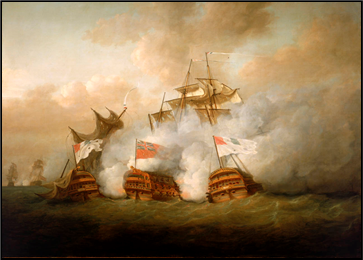 xxxxx…… Andxit was in 1794 that an English fleet under the command of Admiral Lord Howe (1726-
xxxxx…… Andxit was in 1794 that an English fleet under the command of Admiral Lord Howe (1726-
Acknowledgements
Robespierre: c1790, artist unknown – Carnavalet Museum, Paris. Marat: by the French portrait painter Joseph Boze (c1746-
G3b-


